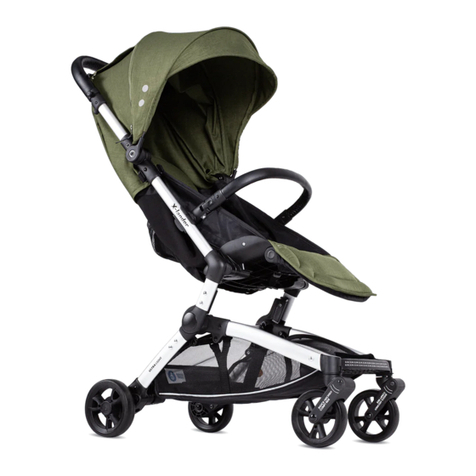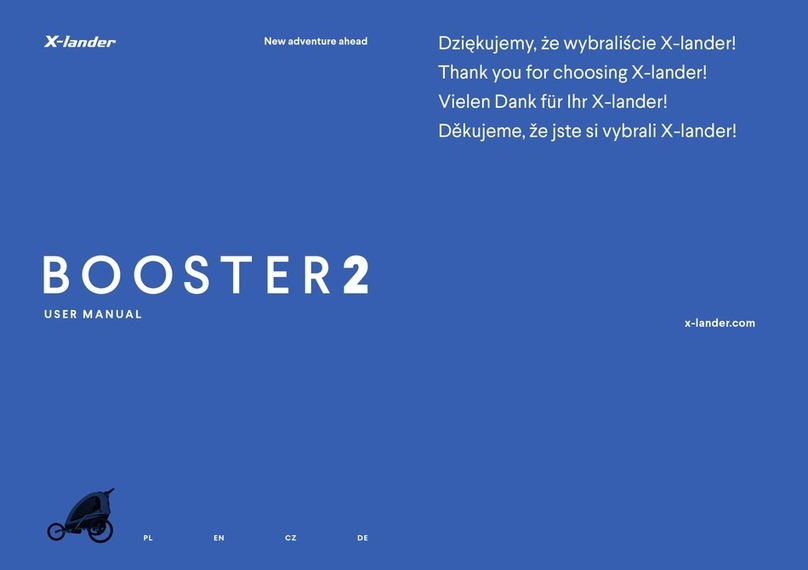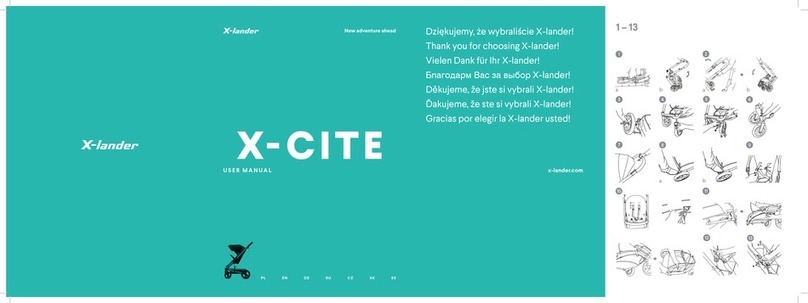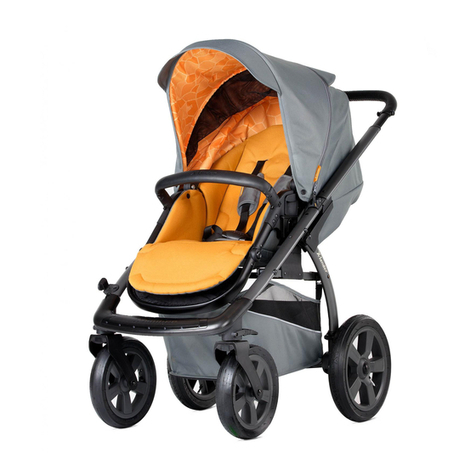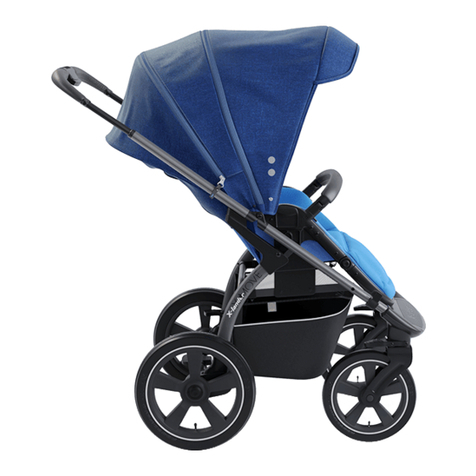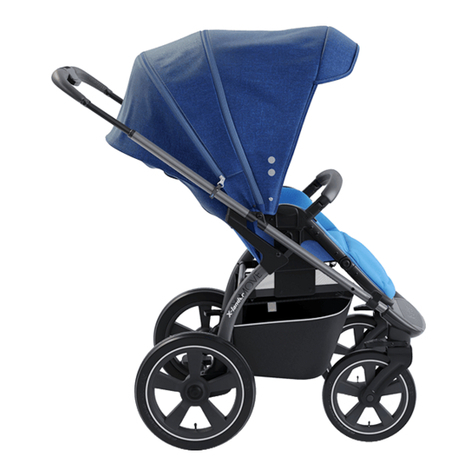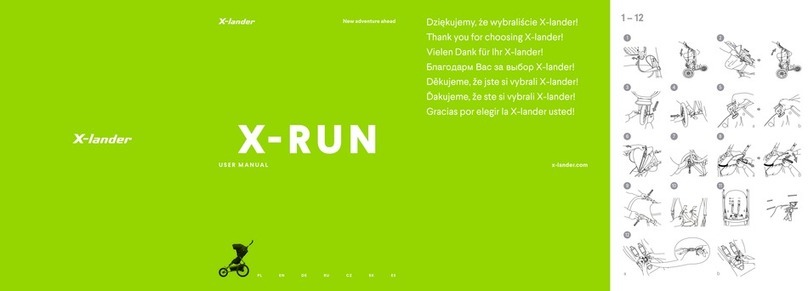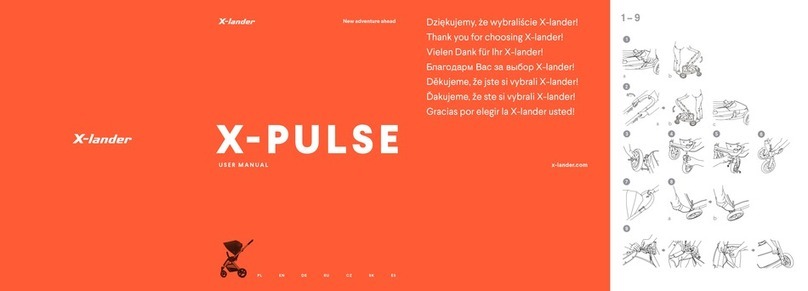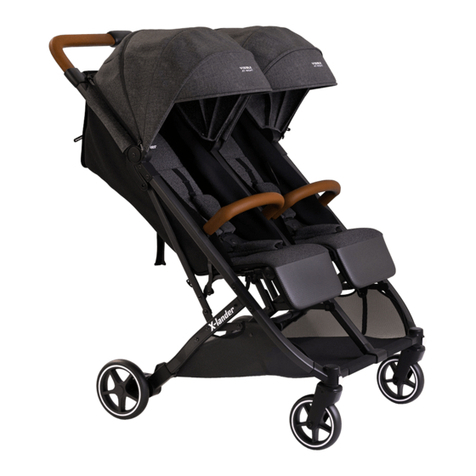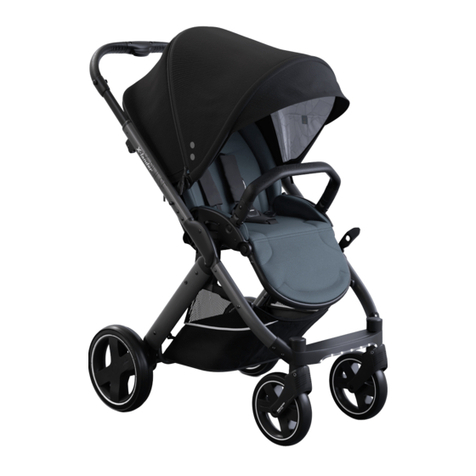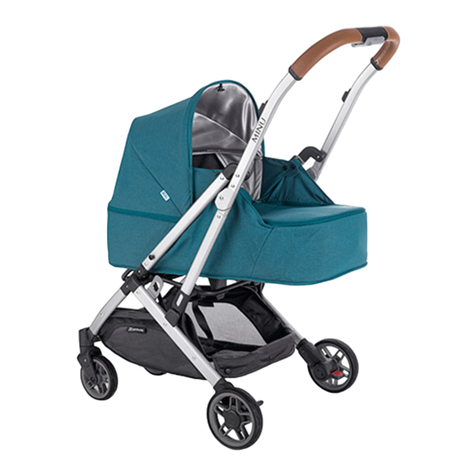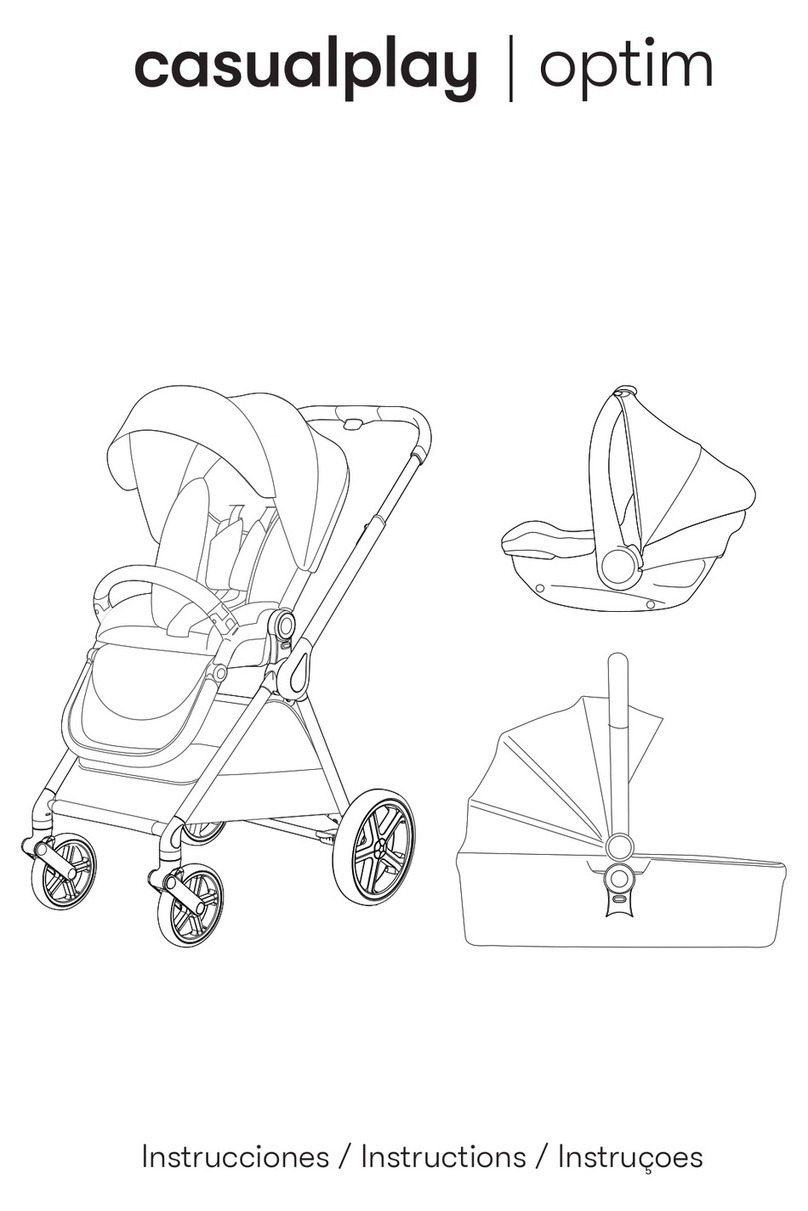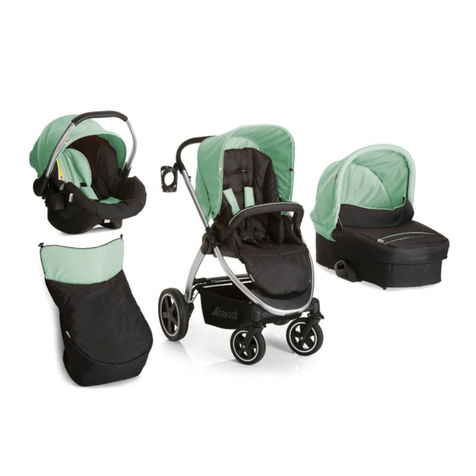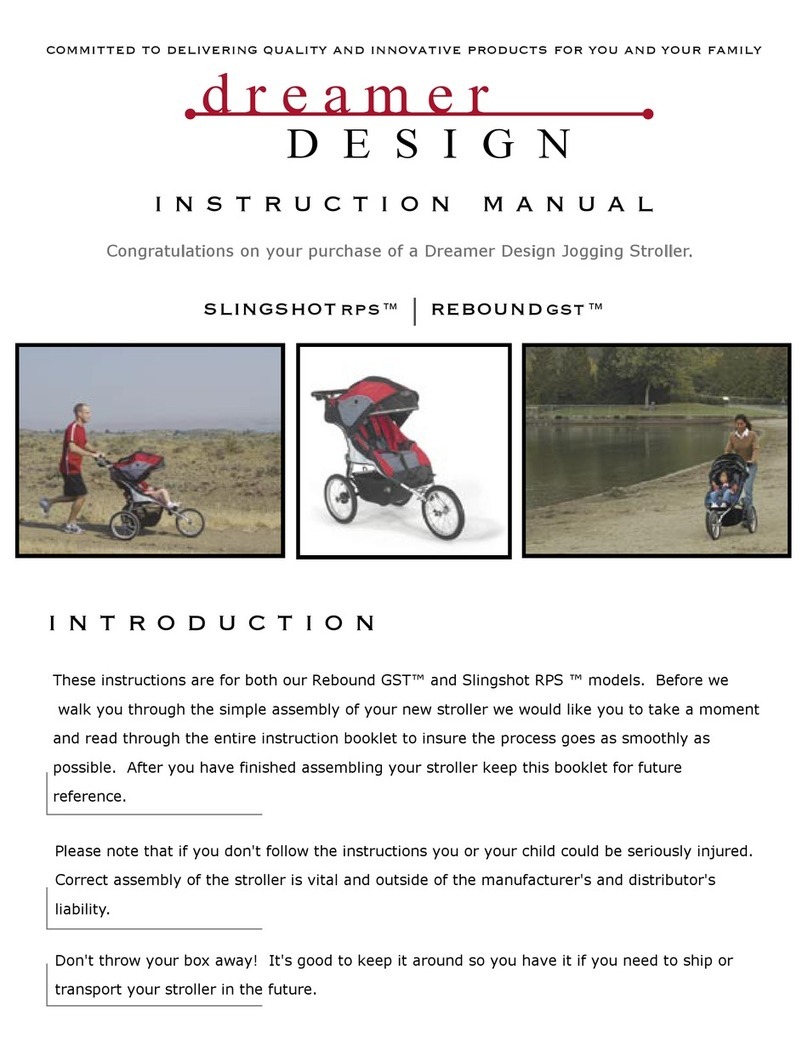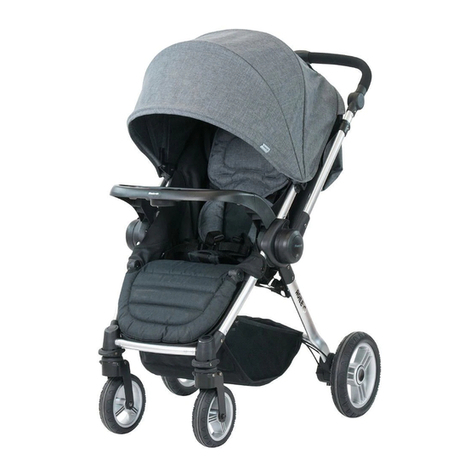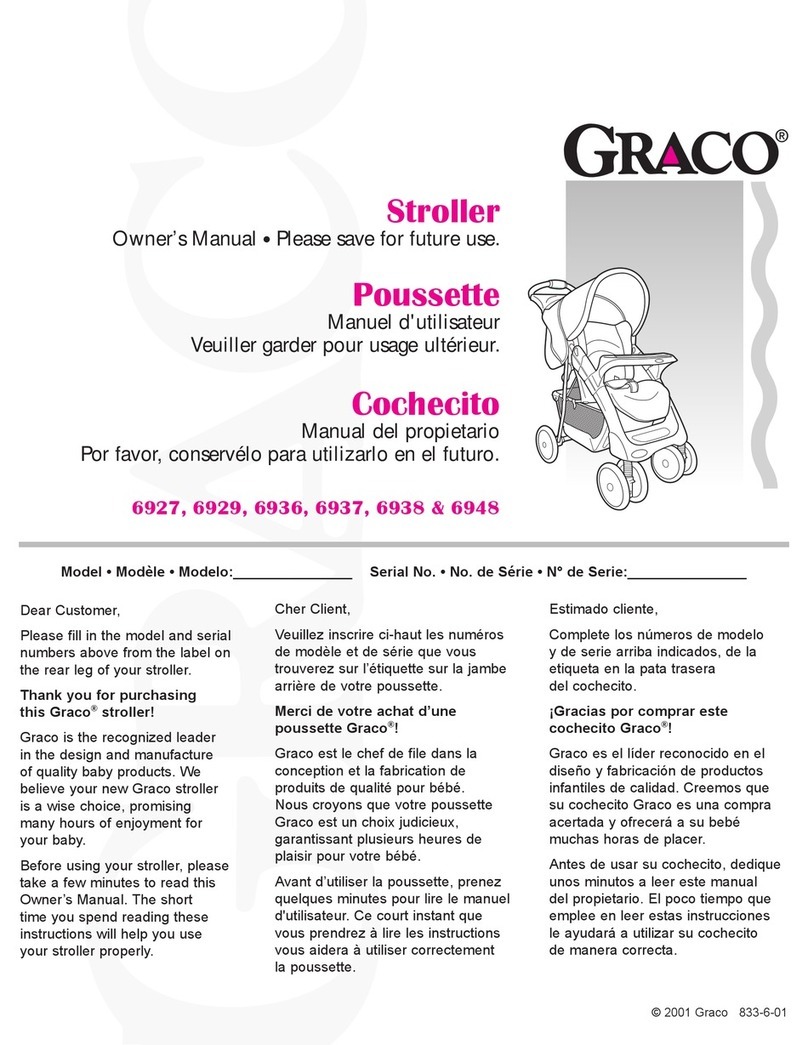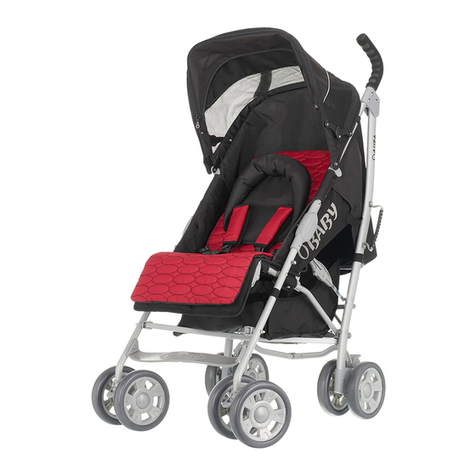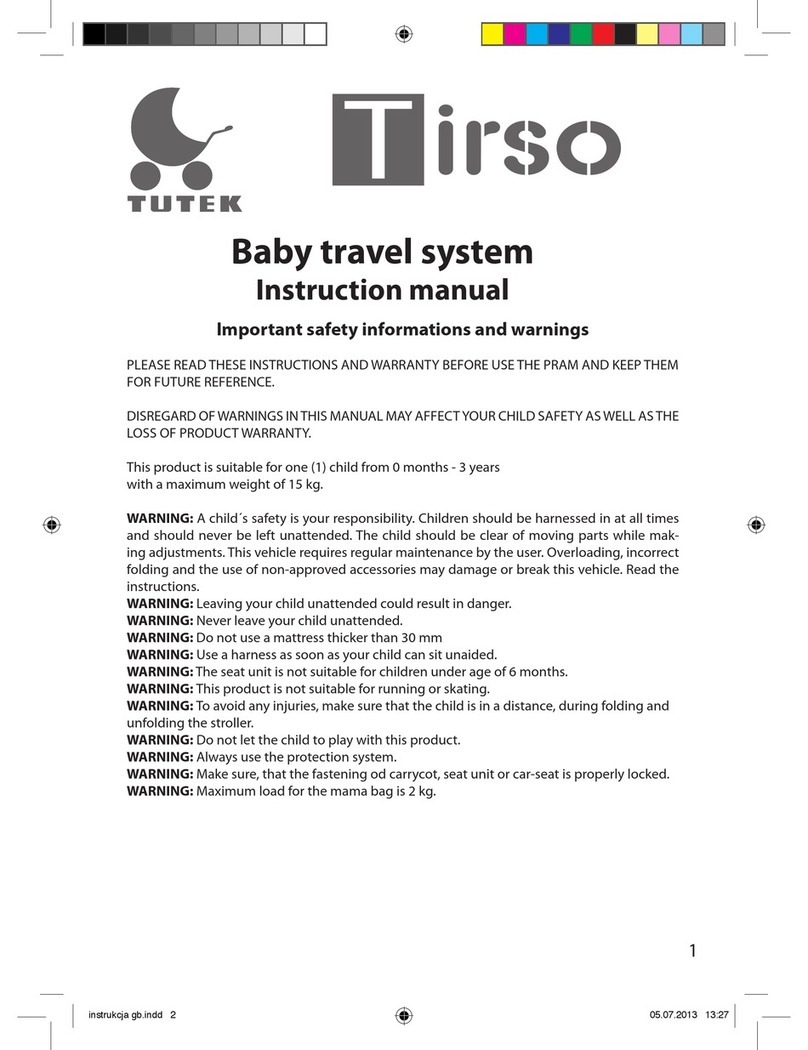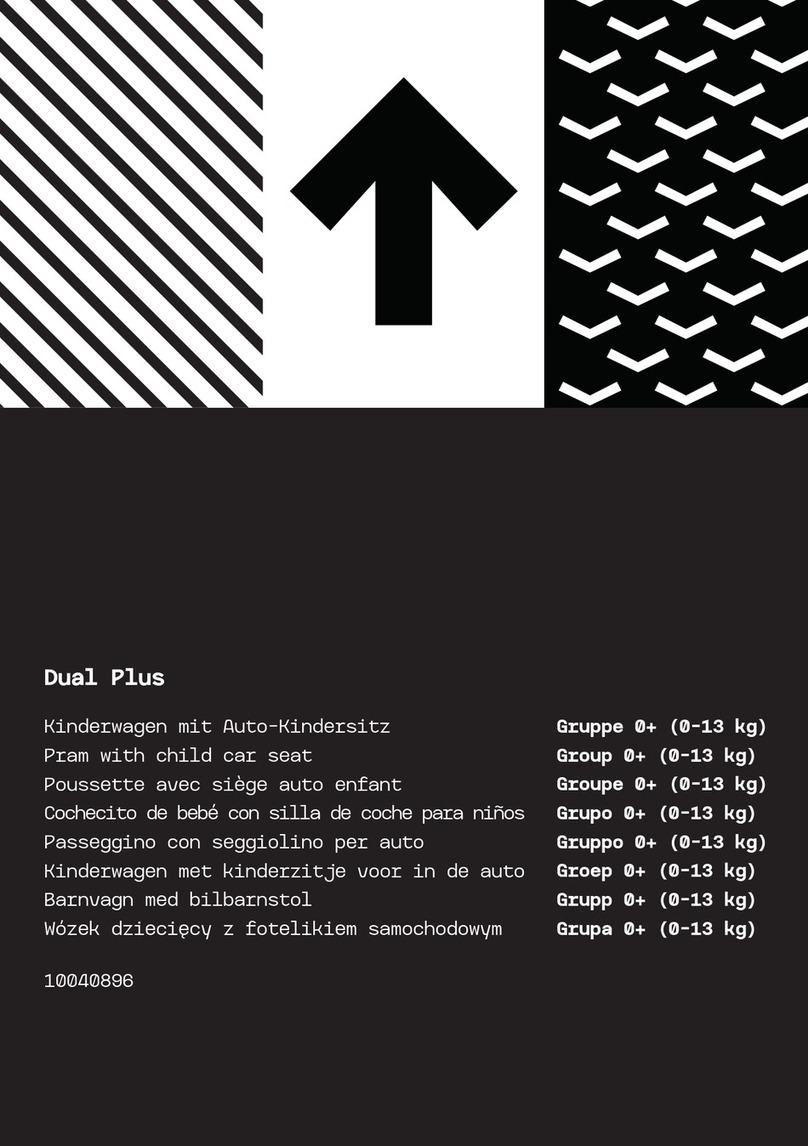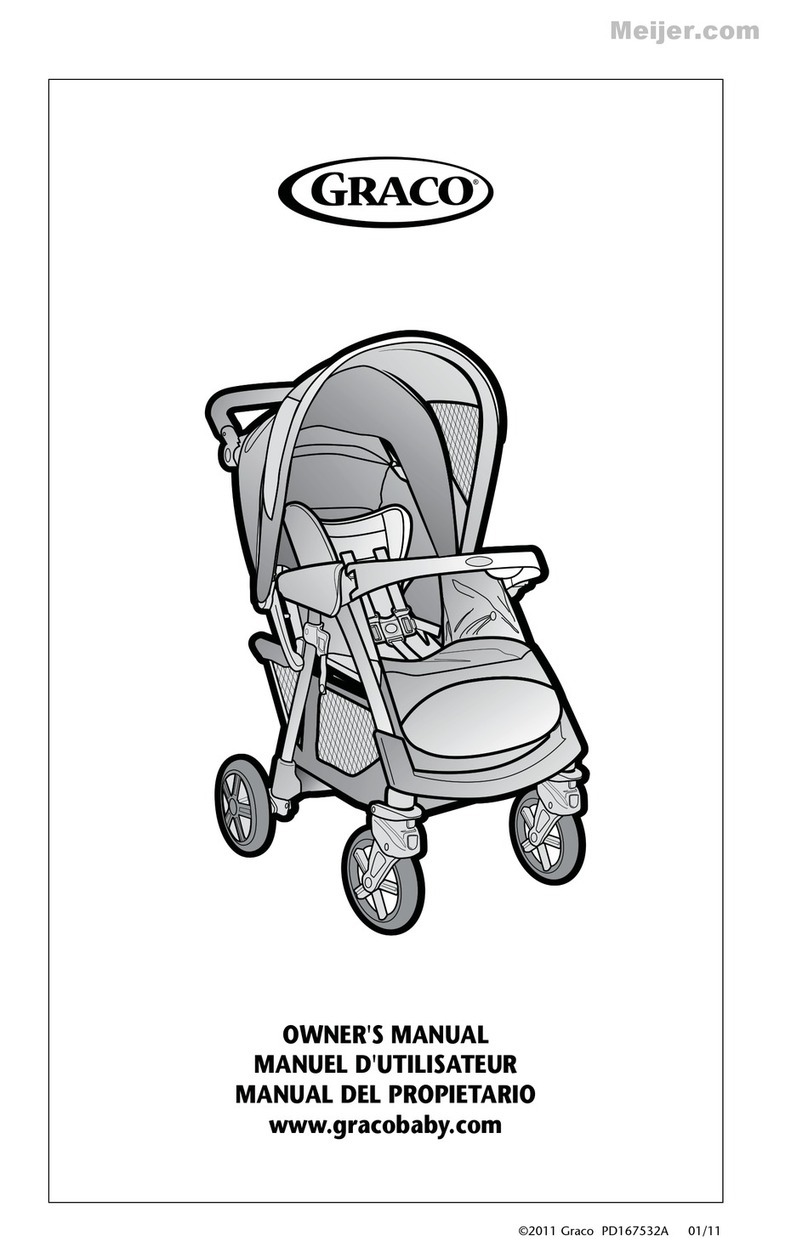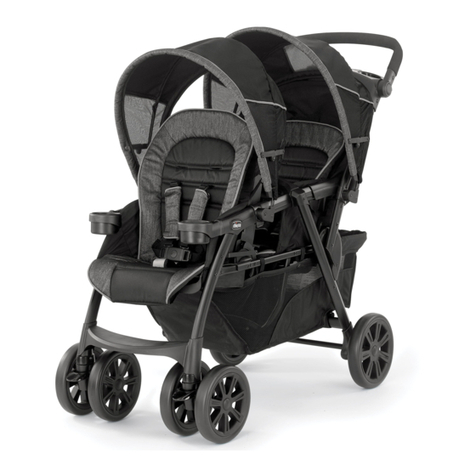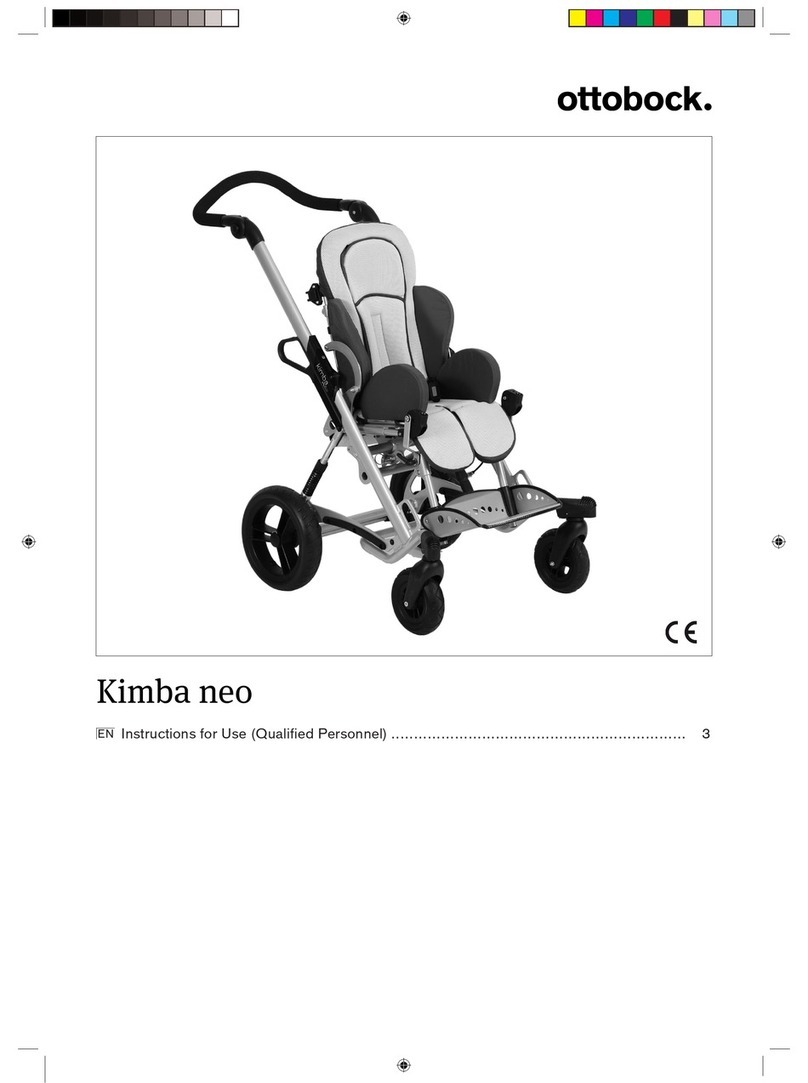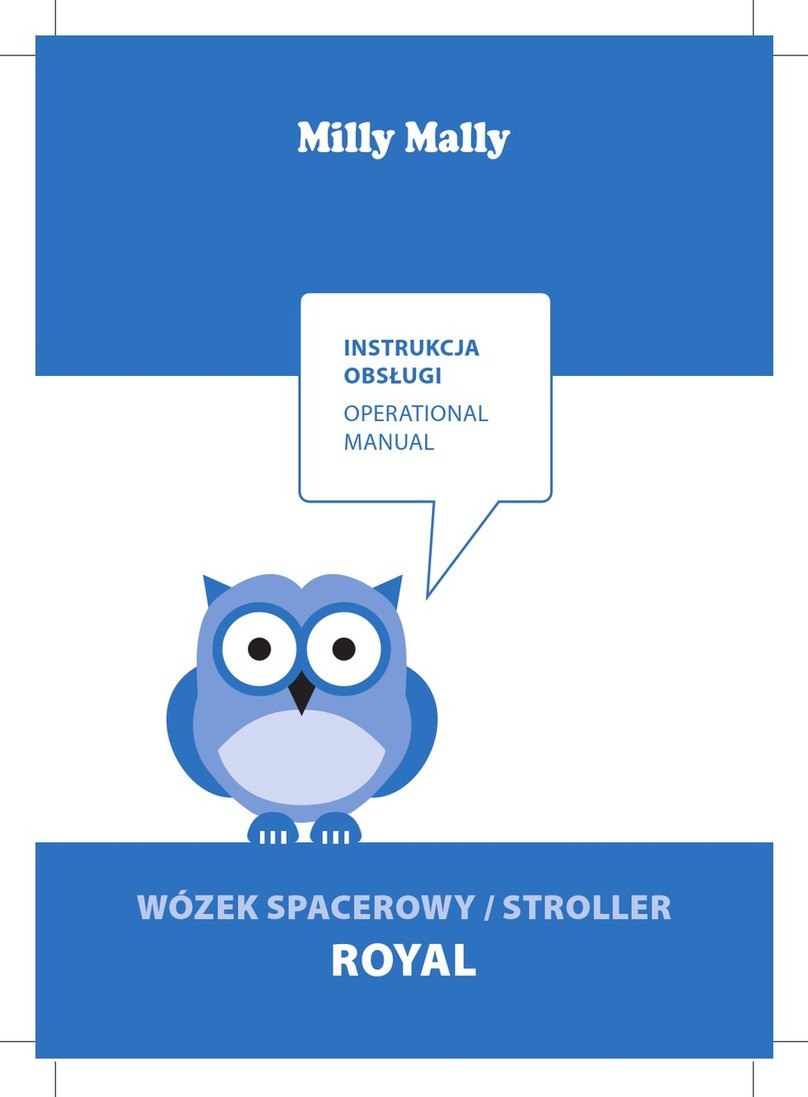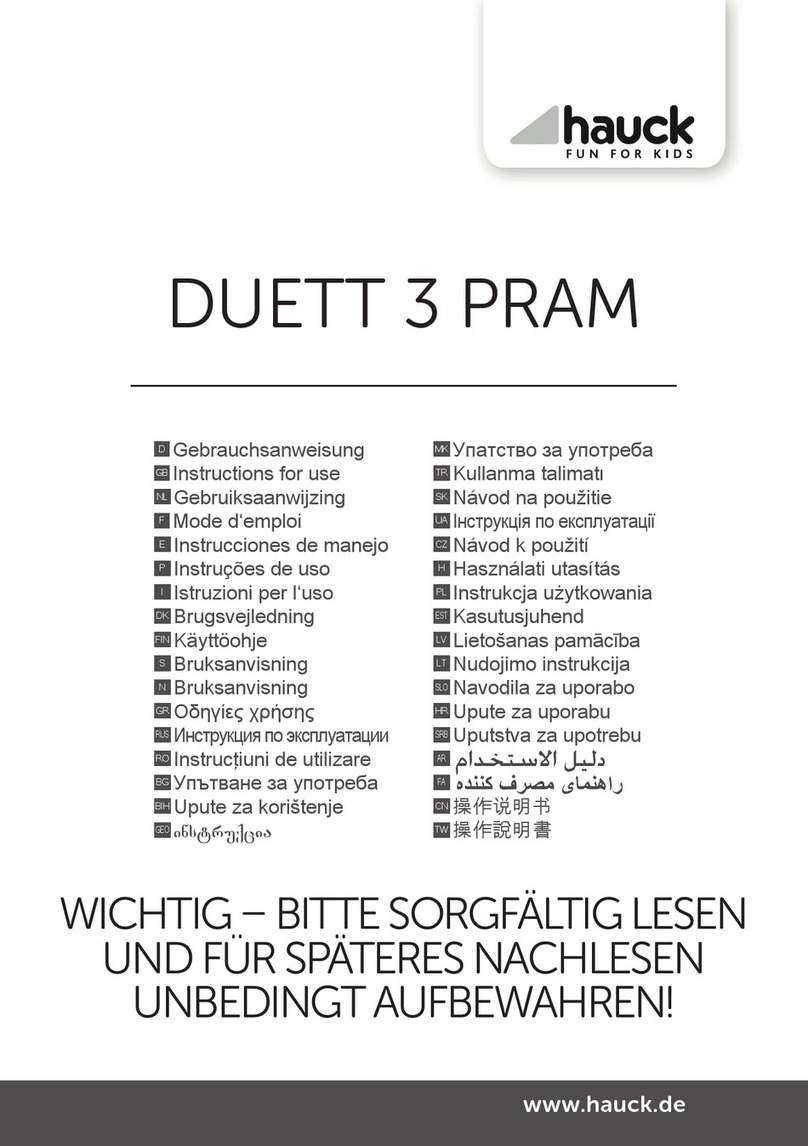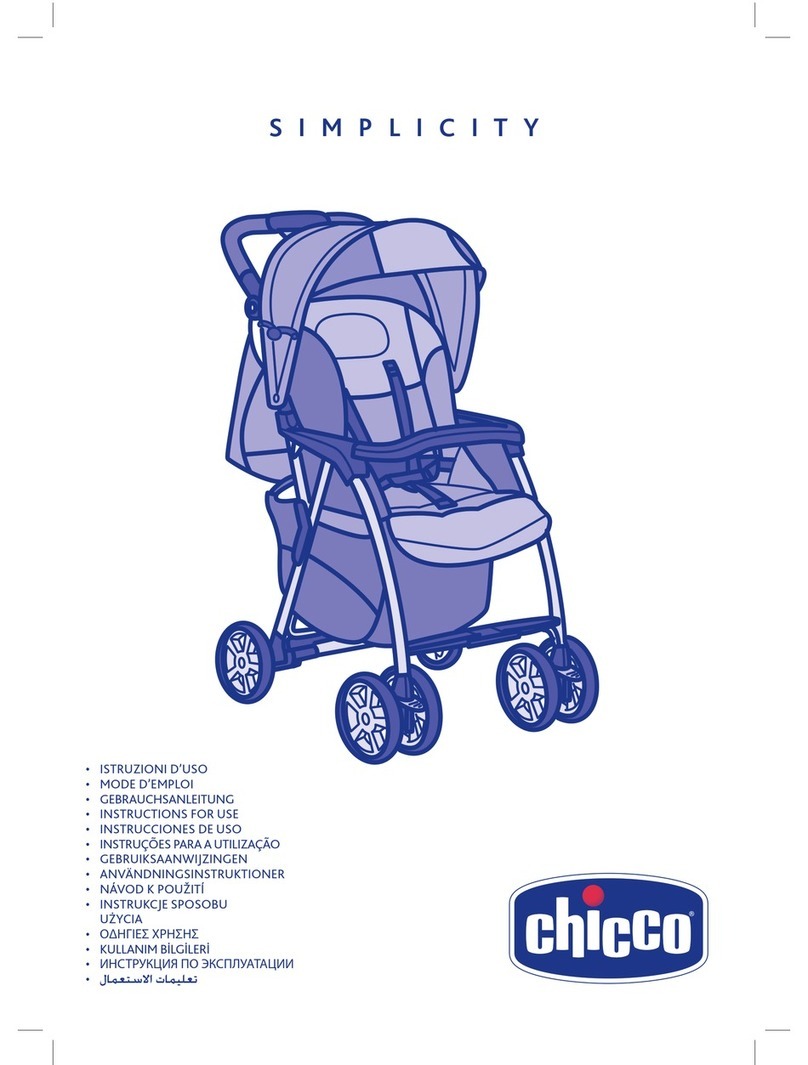
11
POLSKI
18. ZAK£ADANIE DODATKOWEJ WK£ADKI
Rozpi¹æ klamrê szelek i wysun pasy z regulatorów (a). Po³o¿yæ wk³adkê na
siedzisku spacerówki i prze³o¿yæ pasy przez otwory w sposób pokazany na
rysunku (b, c). Zapiaæ na pasach naramiennych ochraniacze na szelki (d,e).
19. KLAMRA
Aby rozpi¹æ klamrê naciœnij przyciski i wysuñ czêœci spinaj¹ce z obudowy.
Aby spi¹æ klamrê wciœnij czêœci spinaj¹ce w obudowê do momentu
zatrzaœniêcia.
20. MONTA¯ FOTELIKA
Aby zamontowaæ fotelik u¿yj specjalnych adapterów. Umieœæ adaptery w
gniazdach monta¿owych stela¿a i za³ó¿ fotelik zatrzaskuj¹c go na adapterach.
Uwaga: Przed u¿yciem sprawdŸ poprawnoœæ zamocowania fotelika.
21. DEMONTA¯ FOTELIKA
Aby zdj¹æ fotelik wciœnij przyciski odblokowuj¹ce po obu jego stronach równo-
czeœnie wyci¹gaj¹c go z gniazd monta¿owych. Zdejmij adaptery wciskaj¹c
przycisk odblokowuj¹cy.
22. MONTA¯ GONDOLI
Aby zamontowaæ gondolê u¿yj specjalnych adapterów. Umieœæ adaptery w
gniazdach monta¿owych stela¿a i za³ó¿ gondolê zatrzaskuj¹c j¹ na adapterach.
23. DEMONTA¯ GONDOLI
Aby zdj¹æ gondolê wciœnij przyciski odblokowuj¹ce zaczepy (a) i wyci¹gnij j¹
z gniazd monta¿owych (b). Zdejmij adaptery wciskaj¹c przycisk odblokowuj¹cy.
OSTRZE¯ENIA I UWAGI
Wa¿ne - Zachowaj te instrukcje do póŸniejszego wykorzystania.
Na podstawie przeprowadzonych testów firma Deltim deklaruje, ¿e dostar-
czony wózek dzieciêcy jest produktem bezpiecznym spe³niaj¹cym wszystkie
wymagania normy PN-EN1888:2012.
UWAGA: Wszelkie dodatkowe wyposa¿enie nie wymienione przez producen-
ta nie powinno byæ stosowane.
Na podwozie X cite mo¿na montowaæ jedynie przystosowane produkty:
gondolê - Xlander, spacerówkê - X cite oraz fotelik - przy u¿yciu odpowiednich
adapterów.
- Stela¿ w po³¹czeniu z gondol¹ X lander stanowi wózek dzieciêcy przezna-
czony dla dzieci w wieku od momentu urodzenia do momentu kiedy zacznie
samodzielnie siadaæ - do 9 kg.
- Stela¿ w po³¹czeniu ze spacerówk¹ X cite stanowi wózek dzieciêcy
przeznaczony dla dziecka, które zaczyna samodzielnie siadaæ ( powy¿ej 6-go
miesi¹ca ¿ycia, do 15 kg).
- Stela¿ w po³¹czeniu z fotelikiem (tylko przy u¿yciu adapterów) s³u¿y dla dzie-
cka od momentu urodzenia do 13 kg. ( zgodnie z instrukcj¹ obs³ugi fotelika).
W ka¿dej opcji mo¿na przewoziæ tylko jedno dziecko.
1. OSTRZE¯ENIE: Nigdy nie u¿ywaj produktu, gdy jego czêœæ jest zu¿yta lub
uszkodzona. U¿ytkowanie niesprawnego produktu zagra¿a bezpieczeñstwu
dziecka. Nale¿y skontaktowaæ siê z punktem serwisowym celem usuniêcia
usterki.
2. OSTRZE¯ENIE: Produkt powinien byæ regularnie sprawdzany pod k¹tem
oznak zu¿ycia lub uszkodzeñ.
3. OSTRZE¯ENIE: Nigdy nie zostawiaj dziecka bez opieki.
4. OSTRZE¯ENIE: Upewnij siê przed u¿yciem wózka, ¿e mechanizmy sk³a-
dania zosta³y zablokowane.
10
POLSKI
5. OSTRZE¯ENIE: W celu unikniêcia skaleczenia upewnij siê ¿e twoje dzie-
cko jest trzymane z dala, kiedy produkt jest sk³adany b¹dŸ rozk³adany.
6. OSTRZE¯ENIE: Nie pozwól dziecku na zabawê z tym produktem.
7. OSTRZE¯ENIE: U¿ywaj uprzê¿y zawsze, gdy twoje dziecko zacznie sa-
modzielnie siadaæ.
8. OSTRZE¯ENIE: Ta spacerówka jest nie odpowiednia dla dzieci poni¿ej
6-go miesi¹ca ¿ycia.
9. OSTRZE¯ENIE: Zawsze u¿ywaæ paska krokowego w po³¹czeniu z pas-
kiem biodrowym.
10. OSTRZE¯ENIE: Przed u¿yciem wózka sprawdŸ prawid³owoœæ zamoco-
wañ gondoli lub siedziska lub fotelika samochodowego do podwozia.
11. OSTRZE¯ENIE: Ten produkt nie jest odpowiedni do biegania i jazdy na
rolkach.
12. OSTRZE¯ENIE: Ka¿de obci¹¿enie zawieszone na prowadnicy, z ty³u
oparcia i/lub na bokach wózka narusza jego statecznoœæ. Maksymalne obci¹-
¿enie torby:1,5kg; Maksymalne obci¹¿enie kieszeni 1kg; max obci¹¿enie
kosza 3kg.
13. OSTRZE¯ENIE: Nie dopuszczaæ do zabawy dzieci w pobli¿u tego pro-
duktu bez opieki.
14. Nigdy nie zje¿d¿aj/wje¿d¿aj wózkiem po schodach i schodach rucho-
mych zw³aszcza gdy jest w nim dziecko. Mo¿e to zagra¿aæ bezpieczeñstwu
dziecka i uszkodziæ produkt.
15. Produkt ten nie jest zabawk¹, wiêc nie pozwól dziecku bawiæ siê nim /
wspinaæ siê na niego. Przewrócenie wózka na dziecko mo¿e spowodowaæ
powa¿ne obra¿enia.
16. Nie u¿ywaj i nie pozostawiaj wózka/gondoli w pobli¿u otwartego ognia
lub innych Ÿróde³ ciep³a takich jak grzejniki.
17. Nigdy nie ci¹gnij wózka, gdy przednie obrotowe ko³a znajduj¹ siê za
Tob¹ i nie s¹ zablokowane. W takiej sytuacji wózek mo¿e samoczynnie skrê-
ciæ, co mo¿e prowadziæ do zagro¿enia dla bezpieczeñstwa, jeœli nie postêpu-
jesz ostro¿nie i uwa¿nie.
18. W trakcie transportu œrodkami publicznymi (autobus, metro, poci¹g itp.)
niewystarczaj¹ce jest u¿ywanie tylko hamulca tylnych kó³ wózka. Wózek
mo¿e byæ wystawiony na dzia³anie warunków (nag³e hamowanie, zakrêty i
wyboje w nawierzchni drogi, przyspieszanie itp.), na dzia³anie których nie
zosta³ przetestowany zgodnie z aktualn¹ norm¹ dla wózków (EN1888). Sto-
suj siê do zaleceñ i instrukcji dotycz¹cych bezpiecznego przewo¿enia dzieci
w wózkach w œrodkach transportu publicznego, których zamieszczanie jest
obowi¹zkiem operatorów transportu publicznego.
19. Zalecenia dotycz¹ce bezpieczeñstwa zawarte w tej instrukcji nie dotycz¹
wszystkich mo¿liwych warunków i nieprzewidywalnych sytuacji, które mog¹
wyst¹piæ. Nale¿y zrozumieæ, ¿e zdrowy rozs¹dek, ostro¿noœæ i uwa¿noœæ s¹
czynnikami, które nie mog¹ zostaæ wbudowane w produkt. Czynniki te pozo-
staj¹ obowi¹zkiem osoby u¿ywaj¹cej wózek.
20. Niniejszy produkt zosta³ zaprojektowany i wyprodukowany zgodnie z nor-
m¹ EN1888. Niniejszy produkt nie powinien byæ u¿ywany jako urz¹dzenie
medyczne. Jeœli Twoje dziecko podczas transportu wymaga specjalistycznej
opieki medycznej, skonsultuj siê ze swoim lekarzem.
21. Nie modyfikuj niniejszego produktu, poniewa¿ mo¿e to zagroziæ bezpie-
czeñstwu Twojego dziecka. Producent nie ponosi odpowiedzialnoœci za jakie-
kolwiek modyfikacje produktu wprowadzone przez u¿ytkownika.
